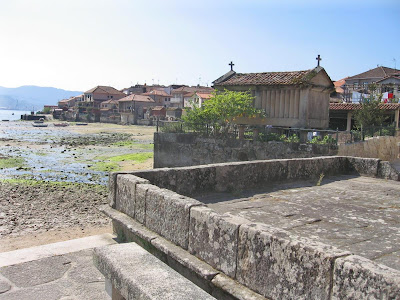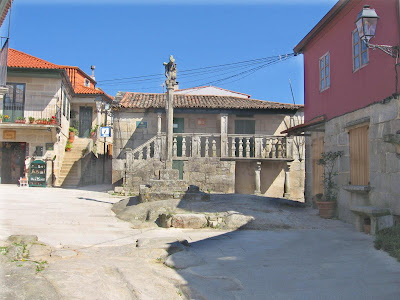Wednesday 25th March 2009, Portonovo, Galicia
This evening we are just about as far west as it is possible to be in Europe and at 8.15pm the sun is just dropping into the sea, leaving the horizon suffused with all shades of red from deep purple to orange.
It was so cold in Modestine this morning that we had to get out our fan heater, but gradually the day warmed up so that by lunch time we were enjoying 25 degrees of sunshine. Almost overnight it seems the leaves have appeared on the trees so that rather than stark branches, everywhere is a haze of bright, fresh green. Flowers too are blossoming in parks and gardens with camellias, lilies, rhododendrons and azaleas adding bright splashes of colour against granite walls.
As we visited the headland of Fisterre (see entry for 24th February 2006) on our last visit we decided to miss it this time, instead exploring a couple of the headlands further south. With hindsight we regret this as they in no way measure up to the spectacular coastal ride out to the furthest western tip of Europe. On the map it looks as if our road follows the coast while in fact there is much recent ribbon development between the little towns, hiding the sublime coastal scenery from view. Spanish towns are almost invariably ugly with few recent building of any architectural merit. Most people live in flats, many faced with unpleasant ceramic tiles. While each little town has nothing actually wrong with it, they are all very dull and uninteresting. Turn down a side road to the sea however, and the scenery is stunning. Along this stretch of the coast there are several rias – wide coastal inlets cutting inland from the sea, flanked by rocky, granite cliffs topped with heathland, gorse and spring flowers. Along the water's edge there are countless deserted beaches of clean, golden sand where huge, green lizards, over a foot in length, bask on the warm stones. Out on the water, between the numerous little islands, fishing boats cast their nets and cormorants perch on rocks drying their wings.
At one such cove, we stopped for lunch. Below us, in the clear water, we watched several dogfish swimming together. Two of them had long, thin, dark fishes or eels, attached by their jaws to their sides. What were they? Presumably parasitic creatures of some sort. We think they must be lampreys, which are common here but we know nothing of their habits. (We've just checked and yes, they were lampreys.) Having finished lunch we walked through a tiny woodland of pines and eucalyptus trees to a low rocky promontory with a tall granite calvary, very similar to those we have seen along the coast of Brittany but in addition to Christ and the Virgin, this also had a little statue of Santiago with his pilgrim's hat and cockleshell. Nearby we discovered the village cemetery where, as is the custom in Spain, everybody is buried above ground in little, individual stone cases, stacked one on top of the other – a sort of filing cabinet of the deceased. A stone closes the opening and there are usually plastic flowers and a photo of the inhabitant.

Perhaps the high point of the day was discovering an iron-age village, over 2,000 years old on a rocky headland at Baroña, on the southern shore of the Ria de Muros. We'd parked and walked down through woodland, out onto the deserted cliff tops, ablaze with yellow gorse. The granite here has large feldspar crystals which sparkle and gleam in the bright sunshine. There are low pine trees where pairs of pink breasted birds sang, but otherwise, apart from the wind and the waves, there was total silence. The citadel has obviously been restored but it was a stunning site with the circular walls of its buildings clearly defined on the headland. We clambered through the narrow paths threading between the ancient walls and climbed up above the village from where we had clear views along this so beautiful of coasts, right the way back up to the headland of Fisterre.




Later, we passed through the town of Cambados. It seemed another typical, uninteresting Spanish town until it suddenly opened up into a large, stunningly beautiful granite square surrounded on all sides by attractively faced and carved granite buildings with decorated mullioned windows, coasts of arms above doorways and a church with an open granite tower. In all it was exactly what we might have expected to find in Brittany. Here though, in Galicia, they are able to grow vines and many of the little shops in the surrounding streets were selling the local wines. Out in the fields, in gardens, wherever there was sufficient space, vines had been established. They are grown in a very different manner from France, supported on a high frame where they grow up and over, offering areas of shade beneath during the heat of the summer.




Finally today, still searching for a stretch of unspoilt coastal scenery, we followed the road out to O Grove, a large island linked to the mainland by a sandy spit on the southern shore of the Ria Arousa. Eventually we reached the furthest tip, still without really seeing more than the odd glimpse of the sea between the endless sprawl of houses and flats along the roadside. We ended up in the port area of O Grove. People were converging on the weighing hall where fishermen take their catch, so we followed to see what was happening. It turned out to be a fascinating experience. The fishermen arrived with their catches in plastic buckets and crates. They proceeded to sort them according to species and size and then they were auctioned off to buyers, each holding an electronic gadget used for bidding. It was a Dutch auction where the price fell each second until someone pressed their gadget, registering their bid.



The catches were all laid out in plastic trays on the floor and we were free to wander the rows, gazing on the shapeless, oozing mass of writhing octopus, squids and cuttlefish. There were flat fish, eels, mullet, sea bass, conger eels, hake, dog fish and dozens we didn't recognise. We had no idea there were so many varieties of fish in Spanish waters. There were also shell fish, mussels, scallops and barnacles. These latter are really weird things and we cannot image how they could ever be made into an appetising meal! There were also shrimps and prawns as well as trays piled high with huge spider crabs which never tired of trying to escape!

Our campsite book assured us there was an open campsite further round the headland. We've seen lots of campsites all day but none are open, so we pressed on to here where a lovely Spanish lady without a word of English tried to explain that she was standing in for her son and didn't really know what the prices were or whether our discount card for ACSI sites was valid. So here we are and as her son has still not appeared we don't know what it will cost us here. It seems a pleasant site with lovely views out to sea and we are very comfortable. Some German people nearby came for a chat. They were really friendly and full of good humour. They come from the former East German town of Rostock. Ian told them he'd been there during DDR days and they said, with hoots of laughter, that so had they, but less willingly!! They are really nice people and it's a delight to us to know that our recent unpleasant experience with German campers was very much the exception.
Thursday 26th March 2009, Baiona, Galicia
This evening we are just a few kilometres north of Portugal camped on yet another of the many rias along this coast. There appear to be several interesting things to see in Baiona so rather than press on, we decided to use the all year campsite here and explore the town tomorrow.
This morning our patience was sorely tried by the campsite at Portonova. Wanting to visit the museum at Pontevedra we were ready to leave by 9am. Spain has its own peculiar timetable and we knew everywhere would close between 1 and 5pm. However, we were obliged to wait until 10.30 before anybody arrived to open the campsite office! We could have left the money and gone but they'd taken our camping discount card to ensure we didn't leave without paying. Surely if they intended opening late they could have asked us to pay the night before or at least put up a notice to the effect that the office would open late! We sat waiting for well over an hour getting really cross. A Dutch couple simply lost patience and drove off without paying. It was a shame really as it was a very pleasant site and had it been more conveniently located we'd happily have stayed a couple of nights.
It's been a very enjoyable day after that unfortunate start. First we stopped off at the little fishing port of Combarro where the granite cottages wind steeply up, built directly onto the granite bedrock. The shady little alleys open out into tiny squares, each with a granite Calvary. At the cottage doors sat elderly people, chatting together. Tubs of flowers and mauve wisteria added colour while down between the alleyways the sun sparkled on the water of the bay. The village is famed for all the horreos or little granite drying sheds that line its waterfront and they are certainly picturesque. An elderly resident started to chat, asking where we were from and went on to tell us things about his little town, some of which we understood. He pointed out the governor's house back in the 18th century and told us the governor had gone off and made lots of money in Argentina. Now the village had turned his house into a library and the residents could actually take books home to read just by writing their names on a piece of paper! He was really very friendly and nice!







After a picnic lunch on benches by the port we continued to the surprisingly large town of Pontevedra. Parking was a nightmare and we became completely lost in the tangle of streets. Our one aim was to escape. On our way out we chanced on a parking space and walked for twenty minutes back into the town. It turned out to be well worth it. The heart of the town is largely pedestrianised, and built entirely from granite, the streets lined with handsome 17th and 18th century buildings. There are several attractive squares and hundreds of cafes, most with tables outside, adding colour to the street scene. There are several public gardens with bright flower beds and shady camellia trees filled with pink or white flowers. In the centre of the town is a pilgrim chapel shaped like a coquille St. Jacques, on the route from Portugal up towards Santiago. Unfortunately of course all five museums were closed until 5pm. We've hardly managed to find either a museum or a post office actually open since we've been in Spain!




Continuing south from Pontevedra the route became very steep and hilly. We crawled up winding hills behind heavy lorries and crawled down with others on our tail. One car driver took the bend on a roundabout too fast just in front of us. How he managed not to turn over is a miracle but his brakes and tyres will need urgent attention. It could have been very nasty for us if his skid had continued any further!
That's it for tonight. The lights of the town are shining across the water and Ian has just discovered we can get free wifi here. Time to sort out some photos for the blog!

